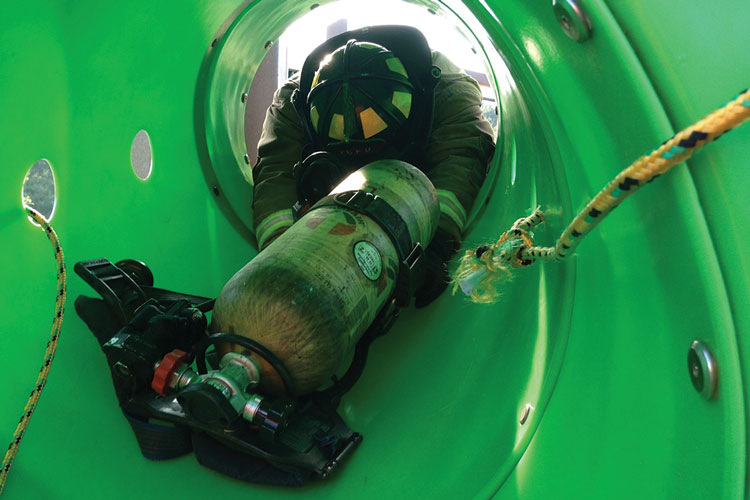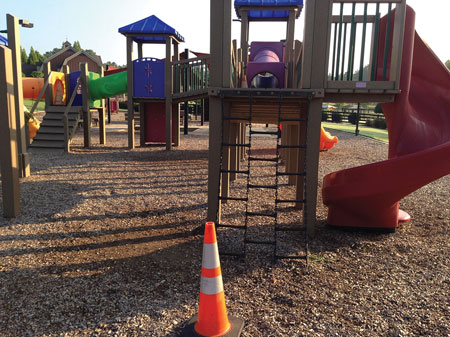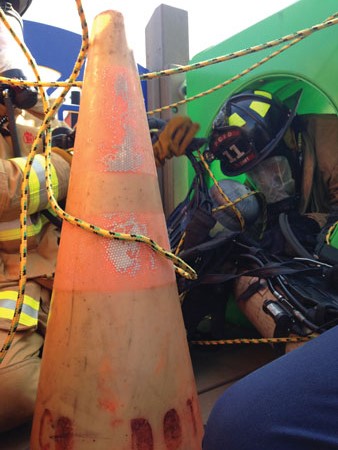
By ROBIN HOUSE
Your local school or neighborhood playground can provide firefighters with a more interesting and different training location (photo 1). Senior firefighters and rookies are often paired up at the station, but they generally have different levels of experience. Most likely, they also have varying degrees of physical fitness and comfort when wearing their gear (especially in full turnout gear) and on self-contained breathing apparatus (SCBA) air. Consequently, personnel may have difficulty operating as a team at live incidents, which necessitates donning full gear and SCBA. These scenes may be further complicated by limited or zero visibility, entanglements, and confined spaces.
 |
| Photos by author. |
To help train personnel to operate as a team in these scenarios, Paulding County (GA) Fire and Rescue devised a one-hour exercise designed to incorporate teamwork, communication, air conservation, restricted passage, entanglement hazards (photo 2), and disorientation. The general exercise requires firefighters to crawl through playground equipment with restricted visibility by blacking out their face pieces. Each firefighter assists his partner in finding and assembling nut/bolt and washer sets placed on top of orange road cones throughout the course.

If you are fortunate enough to have access to a playground set with tunnels, you can direct firefighters through those restricted passages and over unstable surfaces such as rope bridges and chain fences. You also can create entanglements using rope placed throughout the playground.
One very important lesson our department learned is that you must have explicit permission from the school’s administration or homeowner’s association to use the playground for training.
Have at least two members act as safety officers to protect personnel from unintended falls or injuries caused by voids or gaps in the playground equipment. Understandably, your safety officers should pay close attention to SCBA or other personal protective equipment (PPE) malfunctions.
The Drill
If your radio system permits, assign your training scenario to an alternate channel and notify your communications center. Designate a phrase to use in case of a real emergency such as “STOP, STOP, STOP!”

Next, give the team the nut/bolt set at the beginning of the drill. Place washers on four to six cones inside the equipment (photo 3) and drape rope through the inside and outside of the barriers. Place the nut on the last cone at the end of the crawl. Firefighters must crawl through the equipment and complete the evolution by placing all the washers and the nut on the bolt.
Instruct your teams to move slowly enough through the course to locate the washers and nuts without knocking over the cones. Encourage your team members to communicate with each other as clearly as possible while being mindful to conserve their air. This also provides an opportunity to practice disentanglement and low-air alarm procedures (photo 4). Depending on how each scenario goes, there may be a chance to execute Mayday procedures.
Materials Needed
You will need the following materials to conduct this drill:
- Three-inch bolt and nut set.
- Four to six washers.
- Inexpensive rope (at least 50 feet long) that can be cut.
- Four to six orange safety cones.
- Mask “blackout” inserts or wax paper.
- Full PPE including SCBA for each member.
Also consider variations of this training scenario. For example, place a rescue manikin inside the equipment or use different objects on cones. Another option is to have members on a search rope throughout the exercise. Or, begin the exercise with low air or by calling a Mayday.

As with all of your training exercises, it is good practice to discuss the scenario with your crew. In this specific scenario, we have found that debriefing topics generally include communications, movement through restricted passages and entanglements, low-air emergency procedures, disoriented firefighter procedures, and feeling surface textures to determine your location in structures.
This drill costs very little, reinforces basic skills, and gets your firefighters out of the station and into their gear. There is nothing like having been through a tough situation during training when it’s needed during the real thing.
ROBIN HOUSE is a 20-year fire service veteran and a battalion chief (ret.) with Paulding County (GA) Fire and Rescue. House is also a nationally registered paramedic, an arson investigator, and a registered nurse.
USING PROPS, SIMULATORS, AND MOCKUPS FOR MORE REALISTIC TRAINING
The Five-Minute Drill
Give-and-Take Drill
The Nine Tire Drill
Fire Engineering Archives

